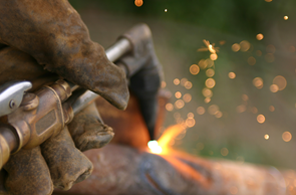Throughout the years, we’ve heard a lot of questionable statements about welding. Some of these have been created by Hollywood’s depiction of welding, while others have been spread through the community by us welders. Today we’re going to be looking at 3 of these potential myths and putting them to the test to see if they really hold up to reality.
1. Drinking Alcohol Helps You Weld Better
Firstly, we do not promote the use of alcohol while using any type of machinery, especially one that heats metal up to 6,300 Degrees F. However, for the sake of this article, let’s look at a longstanding myth within the welding community: Can drinking alcohol improve your welding abilities?
While we’d love to invite a few of our worst enemies over to drink a couple cold ones and see if their welds improve, the health costs could be much higher than our legal retainer. So instead, we’re looking at a very similar, yet less lethal activity: Golf. That’s right, golf. In fact, the same myth exists in golf which states that the more alcohol you consume, the better your swing gets.
So what happens when this myth is put to the test? For this, we’re looking at researchers who actually intoxicated golfers in order to see the change in their performance. According to their study, alcohol definitely did not improve their test subjects’ motor skills, especially their fine motor skills. On a side note, the researchers did find that while performance declined, the amount of raunchy jokes skyrocketed.
The main reason this myth continues to be believed is based on the fact that alcohol tends to lessen your inhibitions and lower your expectations. It’s the classic bar scene. Let’s say someone’s giving you starry-eyes from the stool two seats down. Initially they might not be your type. But after a few drinks, they’re looking more and more like a possibility. The same principle applies in welding. While the alcohol is actually making you weld worse, your expectations of what you’d consider to be a quality weld are also drastically deteriorating.
2. Welding Uses Lots of Fire
We love the scene in How The Grinch Stole Christmas where the little Grinch smashes a bunch of family Jewels and welds them together in an open flame (If you haven’t seen it, make sure to check out the clip below).
The problem is that this scene reflects how Hollywood commonly portrays welding: Burning hot flames. This has spread to the belief that modern welding mainly uses fire. While the myth is less prominent in the welding community than the general public, there’s still plenty of confused beginners out there.
In reality, the most common type of modern welding (arc welding), isn’t done by harnessing the power of fire but actually lightning. In theory, a welding arc is very similar to a miniature lightning bolt. A welding arc is a high voltage electrical arc between your welding electrode and your workpiece. Both lightning bolts and welding arcs show parallel characteristics, such as both arcs follow the path of least resistance. To counteract this myth, we’d prefer if Hollywood would begin to portray welders only as Zeus, the mega-ripped Greek God of Lightning.
3. MIG Monkeys
We once heard a welder say he could teach a monkey to MIG weld in two hours. Talk like that has, in part, led to a belief that MIG requires very little skill. But is MIG welding really as easy as some individuals claim?
That question totally depends on your expectations. According to experts, if you’re looking to create a weld that stays together for at least a couple minutes, 2 hours could be a possible timeline for learning to MIG. But does that constitute as knowing how to MIG weld? We’ll leave that philosophical question up to you.
Most MIG training courses can teach you to become a fairly confident MIG welder in anywhere from a couple months to a year. If you’re not looking to pay tuition, some companies will teach employees how to MIG weld for free when they first start. According to one of these employees, the process generally takes around 2 to 4 weeks before their MIG skills reach an acceptable level. Using machines with auto-set features or technologies like sMIG can also shorten this timeline and improve the quality.
While 2 to 4 weeks to learn the basics is quite quick compared to some other processes, MIG certification test can be incredibly difficult depending on the specifics. So while MIG might take less time to gather the basics than some other welding processes, believing that all MIG welders fit into a single MIG Monkey category is definitely a myth.
That’s just a couple of the myths circulating the welding community. To learn more about questions that welders have been contemplating for years, why not check out any of the posts below:
- Push or Pull
- Plasma or Oxy-Acetylene
- What Really is Duty Cycle?








